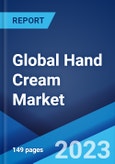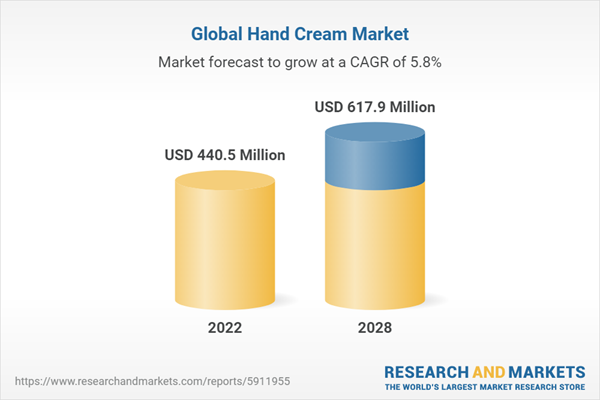Hand cream is a body care product formulated using water, triethanolamine, propylene glycol, stearic acid, methyl stearate, lanolin, and mineral oil. It has a thick consistency owing to a strong emollient base as compared to lotions. It assists in preventing dryness, combating the signs of premature aging, boosting moisture levels and skin elasticity, and protecting against ultraviolet (UV) exposure, which causes cracking and pigmentation. As it also reduces the clinical symptoms of irritant contact dermatitis, its sales are increasing across the globe.
Hand Cream Market Trends
Due to the outbreak of the coronavirus disease (COVID-19), the World Health Organization (WHO) released a community campaign stating that hand hygiene plays a pivotal role in preventing the spread of pathogens. It has also suggested policymakers offer the necessary infrastructure required for the effective performance of hand hygiene in public places. This resulted in the frequent washing and increasing dryness of hands by individuals and consequently rising demand for hand creams around the world. Furthermore, the easy availability of eco-friendly hand creams made from organic and vegan ingredients are propelling the growth of the market. Moreover, leading players are focusing on the launch of innovative products with attractive and biodegradable packaging to expand their product portfolio. These players are also introducing product variants made using aromatic fragrances like shea butter, vanilla, honey, and aromatherapy or botanic notes. Besides this, they are considerably investing in engaging promotional campaigns like celebrity endorsements to create brand awareness and retain a competitive edge in the market. Furthermore, rapid urbanization, rising sales of smart devices, and increasing penetration of the internet is strengthening the e-commerce sector. This, in turn, is offering lucrative growth opportunities to key players.Key Market Segmentation
This research provides an analysis of the key trends in each sub-segment of the global hand cream market report, along with forecasts at the global, regional and country level from 2023-2028. The report has categorized the market based on product, age group, demographic and distribution channel.Breakup by Product:
- Repair Hand Cream
- Anti-Aging Hand Cream
- Whitening Hand Cream
- Overnight Hand Cream
Breakup by Age Group:
- Generation X
- Baby Boomers
- Millennials
- Generation Z
Breakup by Demographic:
- Male
- Female
Breakup by Distribution Channel:
- Supermarkets and Hypermarkets
- Specialty Stores
- Pharma and Drug Stores
- Online Stores
Breakup by Region:
- North America
- United States
- Canada
- Asia-Pacific
- China
- Japan
- India
- South Korea
- Australia
- Indonesia
- Europe
- Germany
- France
- United Kingdom
- Italy
- Spain
- Russia
- Latin America
- Brazil
- Mexico
- Middle East and Africa
Competitive Landscape
The competitive landscape of the industry has also been examined along with the profiles of the key players being Australian Native Botanicals, Beiersdorf AG, Coty Inc., Glossier Inc., Johnson & Johnson, Marks and Spencer plc, Sanofi S.A., Shiseido Company Limited, The Clorox Company, The Procter & Gamble Company and Unilever plc.Key Questions Answered in This Report
1. How big is the global hand cream market?2. What is the expected growth rate of the global hand cream market during 2023-2028?
3. What are the key factors driving the global hand cream market?
4. What has been the impact of COVID-19 on the global hand cream market?
5. What is the breakup of the global hand cream market based on the product?
6. What is the breakup of the global hand cream market based on the age group?
7. What is the breakup of the global hand cream market based on the demographic?
8. What is the breakup of the global hand cream market based on the distribution channel?
9. What are the key regions in the global hand cream market?
10. Who are the key players/companies in the global hand cream market?
Table of Contents
Companies Mentioned
- Australian Native Botanicals
- Beiersdorf AG
- Coty Inc.
- Glossier Inc.
- Johnson & Johnson
- Marks and Spencer plc
- Sanofi S.A.
- Shiseido Company Limited
- The Clorox Company
- The Procter & Gamble Company
- Unilever plc
Methodology

LOADING...
Table Information
| Report Attribute | Details |
|---|---|
| No. of Pages | 149 |
| Published | November 2023 |
| Forecast Period | 2022 - 2028 |
| Estimated Market Value ( USD | $ 440.5 Million |
| Forecasted Market Value ( USD | $ 617.9 Million |
| Compound Annual Growth Rate | 5.8% |
| Regions Covered | Global |
| No. of Companies Mentioned | 11 |









